September 16 – 18, 2019
Written by Diana
My maternal grandfather’s mother was born Hughena McLeod. I have been able to trace this branch of my family tree back to my 5th great-grandfather, Alexander II MacLeod, who was born in 1689 on the Isle of Skye.
We visited the Dunvegan Castle and Gardens, which is the oldest continuously inhabited castle in Scotland. It is the ancestral home of the Chiefs of Clan MacLeod (pronounced McCloud) for 800 years. We had heard how beautiful the Isle of Skye was, but it was a bonus when we learned that we could visit the MacLeod Castle. This was one of the highlights of our trip.

Inside there are lots of artifacts and displays to explain the history of Clan MacLeod. We enjoyed touring the castle, including this beautiful dining room.
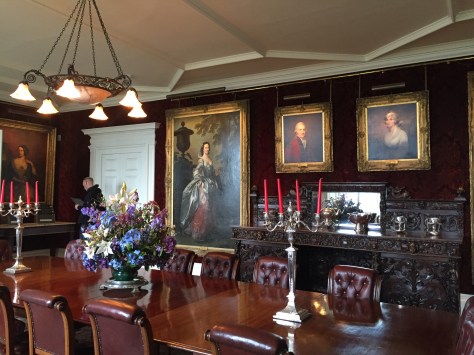
The gardens were beautiful as well and even included this waterfall.
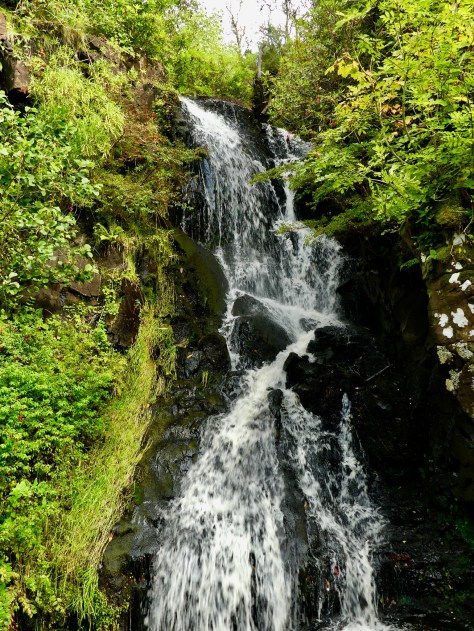
This was the sunset out the front window of our motorhome that evening.
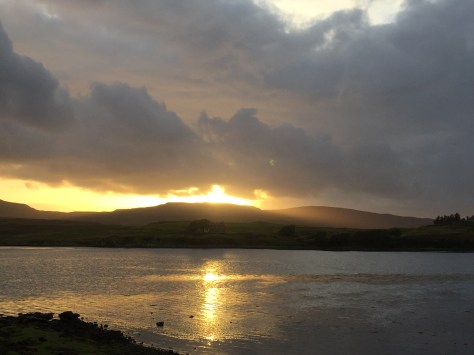
The next morning we went to the Skye and Lochlash Archive Centre to learn more about my family history.

Two genealogists researched my ancestors, but weren’t able to find additional information. They thought it was good that I had already gotten so far back. They were able to fill in more about how my ancestors may have lived, and what may have led them to immigrate to Canada.
Of course my ancestors didn’t live in the castle. This is an example of the homes that were common over 100 years ago. They would gather drift wood to use for the roof. The agricultural system of Skye is crofting. Tenet farmers work land that is owned by other landlords, including the government. After the Highland Clans were defeated at Culloden in 1746, the government of Great Britain saw to it that all who fought for the Jacobite cause were punished. One result was that the rents were drastically raised for the crofters, which led to them being evicted. Many landowners began renting to sheep farmers instead. This led many crofters to emmigrate looking for a better life. Others stayed and have continued this life style. Laws have changed to protect the crofters and assure they are given fair treatment.
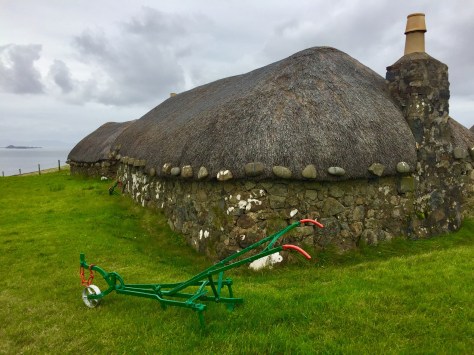
In the afternoon we drove the beautiful Trotternish Peninsula Loop.
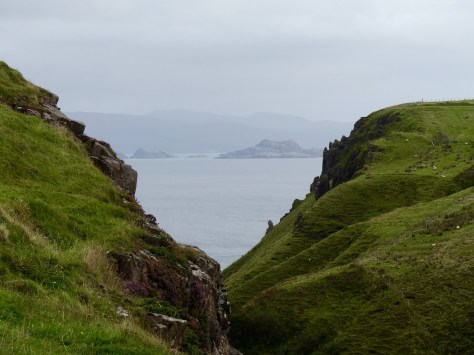
We got out and enjoyed several walks just taking in this scenery.

It was truly breathtaking, and we were sad when we had to leave this beautiful island.
Next up, we head through some spectacular scenery to see some very unique Scottish sites. You will want to be sure to check that out. Until then, safe and happy travels to all!

How great to learn more about your ancestors. I fell in love with Isle of Skye when we were there. We missed the castle you visited. Thanks for sharing it with us.
LikeLiked by 1 person
We also fell in love with Isle of Skye, Beth. We used the bridge to get there, and came back by ferry. When we looked back toward the island from the ferry, there was a huge rainbow. Such a nice memory.
LikeLiked by 1 person
Diana, I’m so very happy for you to visit and enjoy your family history. Take care can’t wait to see and talk with your about your travels. Fred
Sent from my iPhone
>
LikeLiked by 1 person
Thanks Fred! Can’t wait to see you and Bonnie and hear about your summer!🌴⛱
LikeLike
How exciting to learn how your ancestors lived. Sure is beautiful country.
LikeLiked by 1 person
Thanks Gaelyn! It was nice the way the genealogist talked about them having a close connection to the land. We loved Isle of Skye!
LikeLike
How wonderful! What is a crofter?
LikeLiked by 1 person
Thanks for the question, Debbie. A crofter is what they call someone in Scotland who works the land that is owned by someone else. They would pay the value of part of their harvest as rent. In Michigan in the early 20th century it was called share croppers. In Ireland they were called tenant farmers.
LikeLiked by 1 person
Great job tracing your ancestry back as far as you did! Those sure are interesting houses, looks like they were built to last centuries.
LikeLiked by 1 person
It’s amazing how people just used that materials that were available to them, Jim. The houses now are quite nice. The government has given help to the crofters to build homes. The government was smart in not building the houses for the people. It was cheaper to just help pay for materials, as the community will pitch in and help their neighbors build a home.
LikeLike
It must give you goose bumps, Diana, to be there in the area your family roamed. What a special treat to see your family name attached. Thanks for sharing you history and your trip. Safe travels!
LikeLiked by 1 person
It was very special. We figure that much of the farm land would have looked very similar to when my ancestors lived there.
LikeLike
Diana, I am really enjoying your travels!
LikeLiked by 1 person
Thanks Michaelena! We are looking forward to getting back to Florida and hearing about your travels too!
LikeLike
Love Skye and Dunvegan – so many stories. It’s a mistake to see the Jacobite rebellion as a Scotland v England contest though. There were English Jacobites and plenty in Scotland who did not support the Jacobite cause. So it wasn’t “the English saw to it that all who fought for the Jacobite cause were brought low” – it was the the UK Government and it was fairly indiscriminate.
LikeLiked by 1 person
Thank you for the clarification . I have edited my post. I have learned a lot in the past year, but I still have a lot of history to learn. 🙂
LikeLiked by 1 person
It’s also very easy to get mixed up over the differences between the various nations and ‘Britain’ and ‘the UK’ and so on. I believe we do this intentionally, to confuse friends overseas as well as ourselves, to maintain our reputation for eccentricity. 🙂
LikeLiked by 1 person
Mike, it’s kinda like people from the United States calling themselves Americans. What about people from Central and South America, aren’t they Americans too? That would mean that Canadians are also Americans. Ethnocentric of us, perhaps. I always tried avoiding this when I was teaching, yet I have found myself using the term in my posts.
LikeLiked by 1 person
Very true. When I was proofing my recent book I went through and, where appropriate, removed replaced references to ‘America’ when I meant ‘the USA’.
LikeLiked by 1 person